"Since the Dignity does not perish on the death of the incumbent, therefore the imperium is perpetual."
Kantorovicz, p. 397.
| Lenin's body in the coffin, laying in state, January, 1924. |
 |
 |
|
|
"The existence of a period of anarchy or a sort of saturnalia, after the deaths of chiefs or their relatives, is a regular phenomenon in certain societies."
Hertz, p. 129.
|
|
|
"The announcement of the death of a chief is the signal for pillage"
Hertz, p. 130.
|
|
| The dead mask of Lenin. |
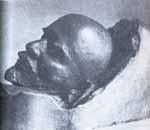 |
 |
|
|
"The death of a chief causes a deep disturbance in the social body which, especially if it is prolonged, has weighty consequences. It often seems that the blow which strikes the head of the community in the sacred person of the chief has the effect of suspending temporarily the moral and political laws and of setting free the passions which are normally kept in check by the social order. Thus we often encounter the custom of keeping the death of the chief secret during a period varying in length; those closest to the deceased are the only ones to know the truth, and they rule in his name; for others, the chief is merely ill."
Hertz, p. 49.
|
|
"In the Sandwich Isles the people are prey to a fury which goes by a special name; nearly all actions normally considered criminal are then committed (arson, robbery, murder etc.), and the women have to prostitute themselves publicly."
Hertz, 129. |
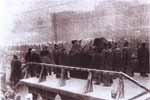 |
 |
|
| In Mikhail Chiaureli's famous film `The Oath` (1946) Stalin swore on the Red Square together with the magnetised people around him. In a long pause of the ceremony a woman approches Stalin who was standing on the catafalque and handed over him a letter addressed to the dead lenin. Stalin here appeared obviously as a reincarnation of Lenin. In reality the oath of allegiance was Read by Stalin five days after Lenin's death on 26 January, 1924 during the second Congress of the Soviets in Moscow. |
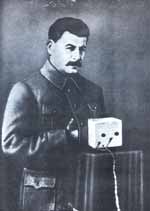 |
 |
|
|
"... in Timor, when a Rajah dies, his successor cannot be officially named until the corpse has had its final burial; for until that burial the deceased is not truly dead, he is simply 'asleep in his house'."
Hertz, 36.
|
|
|
"... death is not completed in one instantaneous act; it implies a lasting procedure which, at least in a great many instances, is considered terminated only when the dissolution of the body has ended."
Hertz, 46.
|
|
| Pictures from David King, The Comissar Vanishes. The series started with an original picture showing Stalin and Lenin in Gorki during Lenin's illness. The photograph suggests a master - disciple relationship between them. Later, on the illustrations of the very same scene Stalin, the disciple gradually grows beyond his master and takes the leading role. With the evolving Stalinist personal cult, Stalin appeared as the reincarnation of Lenin. Stalin did not simply succeed Lenin but effectively replaced Lenin in the reshaped party-mythology by gradually blocking out the image of the great predecessor. |
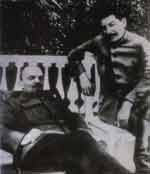 |
 |
|
|
"The same phenomenon is found in another form among the Nigerian tribes of Liberia: the corpse of a king is only finally buried when his successor dies; during the entire reign of the latter, which coincides with the duration of the provisional burial, the ex-king, 'who is not considered to be really dead', watches over his successor and helps him in his functions. Thus a king is truly holder of his office only in the period between his death and that of his successor; in his lifetime he merely exercises a sort of de facto regency."
Hertz, p. 129./Notes
|
|
|
"According to the chronicler Wiponus, the inhabitants of Pavia accused of having destroyed the royal palace after the death of Henry II in 1024, justified themselves to his successor, Conrad II, saying "we cannot be accused of having destroyed the residence of the king, seeing that the king had died." A ship survives the death of its helmsman, Conrad II had retorted: "The king was dead, but the kingdom still endured" (si rex periit, regnum remansit).
Ginzburg, p. 24.
|
|
| Pictures from David King, The Comissar Vanishes. The series show the original picture where Stalin can be seen together with Lenin and Kalinin. Then on a later forged version of the very same photograph only Lenin and Stalin at present, and finally Lenin also disappears. As the contemporary slogan - "Stalin - the Lenin of today" - suggested, Stalin appeared as the reincarnation of Lenin. |
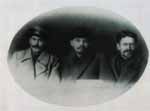 |
 |
|
|
Sources:
- Carlo Ginzburg, Ritual Pillages: A Preface to Research in Progress by the Bologna Seminar. In: Microhistory and the Lost Peoples of Europe, Edited by Edward Muir and Guido Ruggiero, 1991 The Johns Hopkins University Press, Baltimore and London.
- Robert Hertz, Death and the Right Hand. Cohen & West.
- Ernst H. Kantorovicz, The King's Two Bodies - A Study in Medieval Political Theology. Princeton University Press, Princeton, New Jersey 1957.
|
|
|
|








